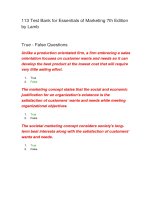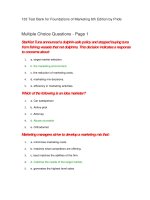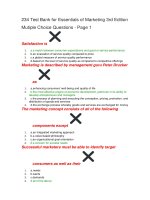Test bank for essentials of genetics 7th edition by klug
Bạn đang xem bản rút gọn của tài liệu. Xem và tải ngay bản đầy đủ của tài liệu tại đây (135.04 KB, 6 trang )
Exam
Name___________________________________
MULTIPLE CHOICE. Choose the one alternative that best completes the statement or answers the question.
1) What is the name of the company or institution that has access to the health, genealogical, and
genetic information of approximately 270,000 residents of Iceland?
A) Biogen
B) National Institutes of Health
C) deCODE
D) American Cancer Society
E) Gattaca
1)
2) A biotechnology company, deCODE, is in the process of creating a database that contains
A) the gene sequences of all newborns in the United States beginning in 2006.
B) all the information available on the human genome project.
C) health, genealogical, and genetic information of approximately 270,000 residents of Iceland.
D) a compilation of all the known genes in humans throughout the free world.
E) a complete sequence of the human genome.
2)
3) Why did deCODE select Iceland for its ambitious research project?
A) frequent and extensive mutational bursts
B) high genetic diversity
C) lack of genealogical information
D) virtual absence of mutation
E) a relatively low degree of genetic diversity
3)
4) The genetic material DNA consists of basic subunits called
A) mitochondria.
B) lysosomes.
C) nucleotides.
D) centrioles.
E) none of the above
4)
5) The immediate product of transcription is
A) a protein.
B) a carbohydrate.
C) RNA.
D) an amino acid.
E) a phospholipid.
5)
6) In many species, there are two representatives of each chromosome. In such species, the
characteristic number of chromosomes is called the ________ number. It is usually symbolized as
________.
A) haploid; 2n
B) diploid; n
C) haploid; n
D) diploid; 2n
E) none of the above
6)
1
7)
7) Genetics is the study of which of the following?
A) diploid and haploid
B) transcription and translation
C) mutation and recession
D) heredity and variation
E) replication and recombination
SHORT ANSWER. Write the word or phrase that best completes each statement or answers the question.
8) Early in the twentieth century, Walter Sutton and Theodor Boveri noted that the behavior
of chromosomes during meiosis is identical to the behavior of genes during gamete
formation. They proposed that genes are carried on chromosomes, which led to the basis
of the ________.
8)
9) What is a mutation? What are chromosomal mutations?
9)
10) What is a simple definition of an allele?
10)
11) Until the mid-1940s many considered proteins to be the likely candidates for the genetic
material. Why?
11)
12) Name the individual who, while working with the garden pea in the mid-1850s,
demonstrated quantitative patterns of heredity and developed a theory involving the
behavior of hereditary factors.
12)
13) What does the term genetics mean?
13)
14) Name the substance that serves as the hereditary material in eukaryotes and prokaryotes.
14)
15) Name two individuals who provided the conceptual basis for our present understanding
that genes are on chromosomes.
15)
16) What term is used to describe the fact that different genes in an organism often provide
differences in observable features?
16)
17) A fundamental property of DNAʹs nitrogenous bases that is necessary for the
double-stranded nature of its structure is ________.
17)
18) Recombinant DNA technology is dependent on a particular class of enzymes, known as
________ that cut DNA at specific nucleotide sequences.
18)
19) Name one of the botanists who, in 1900, rediscovered the work of Gregor Mendel.
19)
20) Genetics is commonly seen as being grouped into several general areas: transmission,
molecular, and population/evolution. What biological processes are studied in
transmission genetics?
20)
21) Who owns transgenic organisms?
21)
2
22) In 1996 a cloning experiment produced the sheep named Dolly. Instead of the more
traditional method of cloning by embryo splitting, Dolly was produced by what
procedure?
22)
23) What term is applied to a variety of projects whereby genome sequences are deposited in
databases for research purposes?
23)
24) The first draft of the human genome sequence was reported in 2001 by two groups: the
publicly funded ________ and the private company ________.
24)
25) A number of genomes have been sequenced in recent years: Escherichia coli, Saccharomyces
cerevisiae, Caenorhabditis elegans, Drosophila melanogaster, and Mus musculus . What are the
common names for the above organisms?
25)
26) What is meant by the term genome? What is a genomic library?
26)
27) In nonviral systems, what is the nature of the hereditary substance?
27)
28) Approximately what percentages of the following crops are genetically modified: corn,
________; soybean, ________; canola, ________; cotton, ________?
28)
29) What is meant by the term gene?
29)
30) Distinguish the functions of DNA and RNA in a eukaryote.
30)
31) Name the bases in DNA and their pairing specificities.
31)
32) What is meant by the term genetic code?
32)
33) Compare and contrast nonenzymatic and enzymatic proteins.
33)
34) List the two relatively complex processes in which genetic information is converted into
functional products.
34)
35) Define two terms that are often used in the description of genetics.
35)
36) What is meant by the phrase the central dogma of genetics ?
36)
37) What is the composition of the genetic material?
37)
38) What is meant by complementarity in terms of the structure of DNA?
38)
39) Reference is often made to adapter molecules when describing protein synthesis. What
does this term refer to?
39)
3
40) Given that DNA is the genetic material in prokaryotes and eukaryotes, what other general
structures (macromolecules) and substances made by the cell are associated with
expression of that genetic material?
40)
41) What is another term for a biological catalyst?
41)
42) Research dealing with what human blood disorder was instrumental in linking the
genotype to a specific phenotype, and what conclusion was reached?
42)
43) A commercially available chip that contains thousands of fields (genetic elements) can be
used to assess an individualʹs genome. What is the name of this chip?
43)
44) Alternative forms of a gene are called ________.
44)
45) The various characteristics of organisms that result from their genetic makeup are
collectively referred to as an organismʹs ________.
45)
46) Organisms that are well-understood from a scientific standpoint and are often used in
basic biological research are often called ________.
46)
47) Arabidopsis is a model organism for the study of ________.
47)
48) In the treatise On the Seed, Hippocrates suggested that the various hereditary traits in the
body were contained in ________.
48)
49) What is the name of the theory which postulates that an organism is derived from
materials originally present in the egg that eventually differentiate into adult structures
during development?
49)
TRUE/FALSE. Write ʹTʹ if the statement is true and ʹFʹ if the statement is false.
50) Genetics is the study of heredity and variation.
50)
51) Complementarity in a genetic sense refers to the polymerization of nucleotides in DNA.
51)
52) Once produced, a transgenic plant or animal can be patented.
52)
53) Archeological evidence indicates that the earliest domestication of plants and animals occurred
within the last 2000 years.
53)
54) Darwinʹs theory of evolution is based on the phenomenon of natural selection.
54)
55) According to the fixity of species doctrine, animals and plants have remained unchanged since their
appearance on Earth.
55)
4
Answer Key
Testname: UNTITLED1
1)
2)
3)
4)
5)
6)
7)
8)
9)
10)
11)
12)
13)
14)
15)
16)
17)
18)
19)
20)
21)
22)
23)
24)
25)
26)
27)
28)
29)
30)
31)
32)
33)
34)
35)
36)
37)
38)
39)
40)
C
C
E
C
C
D
D
chromosome theory of inheritance
A mutation is an inherited change in a gene. A chromosomal mutation affects the number or structure of
chromosomes.
An allele is a variant form of a gene.
Proteins are the most abundant, universally distributed components in cells, and because of their great structural and
functional diversity, they were considered likely candidates.
Gregor Mendel
Genetics is a subdiscipline of biology concerned with the study of heredity and variation at the molecular, cellular,
developmental, organismal, and populational levels.
DNA, or deoxyribonucleic acid
Walter Sutton and Theodor Boveri
phenotype
complementarity
restriction enzymes
Karl Correns
Mendelian inheritance (segregation and independent assortment), modification of Mendelian patterns, pedigree
analysis, and chromosome and pedigree analysis
Once produced, a patent can be obtained on a living organism, thereby offering exclusive use of the transgenic
organism for the patent holder.
nuclear transfer
genomics
Human Genome Project; Celera Corporation
bacterium, yeast, roundworm, fruit fly, mouse
The genome is all the DNA carried in an organism, while a genomic library is a collection of clones that contain the
entire genome.
DNA (deoxyribonucleic acid) is a double-stranded polymer organized as a double helix.
40%; 80%; 60%; 70%
unit of inheritance
DNA is responsible for the storage and replication of genetic information, while RNA is involved in the expression of
stored genetic information.
adenine:thymine, guanine:cytosine
The genetic code consists of a linear series of three adjacent nucleotides present in mRNA molecules.
Both are gene products, with their primary structure being a string of amino acids. Enzymes are required as catalysts
for most biochemical reactions, while nonenzymatic proteins include structural (collagen), protective
(immunoglobins), and/or transport (hemoglobin) proteins.
transcription and translation
Heredity is the similarity between parents and offspring and the similarity of members of the same species. Variation
is the lack of similarity between parents and offspring and members of the same species.
functional and structural relationships among DNA, RNA, and protein
polymers of nucleotides making up DNA
base pairing of A with T and G with C
tRNA
RNA (messenger, ribosomal, transfer), ribosomes, enzymes, proteins
5
Answer Key
Testname: UNTITLED1
41)
42)
43)
44)
45)
46)
47)
48)
49)
50)
51)
52)
53)
54)
55)
enzyme
The work on sickle-cell anemia was instrumental in showing that a mutant gene produced a mutant protein molecule.
microarray
alleles
phenotype
model organisms
plants
humors
epigenesis
TRUE
FALSE
TRUE
FALSE
TRUE
TRUE
6









